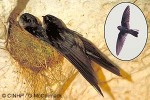Cook Islands Biodiversity Database
Species Page
Aerodramus sawtelli
Kōpeka (AT)Atiu Swiftlet
Multimedia & Additional Resources
| Type | Description | Download |
| Adult & juvenile on nest | 51KB | |
| Close-up - echo-location feathers above eye | 113KB | |
| Adult - wings and tail outspread | 138KB | |
| Adult flying - view from the ground | 134KB | |
| Nesting (© TVNZ) | 663KB | |
| Call on entering the cave (J.Fullard) | 142KB | |
| Call when landing on nest (J.Fullard) | 133KB | |
| Compare White-rumped Swiftlet (Fiji) | 28KB | |
| The Status of Cook Islands Birds - 1996 Gerald McCormack, September 2005 |
Read |
General Information
Cook Islands Distribution
| Southern Group: Present Makatea: | ||||||||
RR |
MG |
AT |
MK |
MT |
AK |
PL |
TK |
MN |
- |
- |
++ |
X |
- |
- |
- |
- |
- |
| Northern Group: - | |||||
TN |
MH |
RK |
PK |
NS |
SW |
- |
- |
- |
- |
- |
- |
Scientific Taxonomy
Aerodramus sawtelli (Holyoak, 1974)
SYNONYMS: Aerodramus leucophaeus sawtelli; Collocalia sawtelli [O]
TAXONOMY: ANIMALIA; CHORDATA; GNATHOSTOMATA (Jawed Vertebrates); TETRAPODA; AVES; NEORNITHES; Apodiformes; APODIDAE. COMMENT: The swiftlets of Atiu, Tahiti and the Marquesas are more similar to each other than any to the west, as in Tonga. Most authorities accept the three swiftlets of Southeast Polynesia as separate species. However, Holyoak (1978) suggested that the three might be considered at near species level by naming them: $Aerodramus (leucophaeus) sawtelli@, $Aerodramus (leucophaeus) leucophaeus@, and $Aerodramus (leucophaeus) ocistus@.
More Information
SIGNIFICANCE NOTES -
BIODIVERSITY: Globally endangered (seriously). Comment: Nests in two caves: Ana Takitaki and Ana Tupurangi. Total nests: 190 (1987), 172 (1994) and 175 (1995). Population is small but relatively stable. In 1987 the 190 nests had 380 eggs and gave 114 fledglings - ie. 30% of the eggs produced a fledgling. 36% of the eggs disappeared, presumably victims of landcrab predation. Nest success was relatively low compared to other swiftlets.
POSITIVE SIGNIFICANCE: Ecotourism. Comments: Visiting the one of the breeding caves is an important visitor experience.
GENERAL NOTE: Atiu Swiftlets nest and roost in completely dark parts of caves. During the non-breeding season they typically leave in the morning between 6-7.30am and return in the evening between 6-7pm. During the breeding season they return about 6 times to feed their young. Outside the cave they never land. They use their excellent vision to catch flying insects over open areas and near trees. In the caves the birds echolocate using a series of audible clicks, which increase in frequency as they approach objects. The clicks have a single pulse of 2-3milliseconds duration. When they land the call clicks are lengthened and this may act as a warning announcement. Takitaki is an imitation of the sound of the swiftlet; and 'ana" means 'cave'.
The most closely related swiftlets are the Tahiti Swiftlet (cliff-nesting and non-echolocating) and the Marquesas Swiftlet (cliff and cave-nesting, the latter echolocating). The White-rumped Swiftlet, eastward to Tonga, is cave-nesting and echolocating - having a two-pulse click.
Swifts and swiftlets are fast fliers. The Needletailed Swift, possibly the fastest-flying bird in the world, can level flight at 170km/hr. The White-rumped Swiftlet of Tonga and Fiji accelerates up to 110km/hr as it enters its caves to avoid predation by Barn Owls.
Vouchers & References
Vouchers:
None Recorded.
References:
Special Reference: Holyoak D.T. (1974) Undescribed land birds from the Cook Islands, Pacific Ocean. Bull. Brit. Orn. Club 94:145-150. Tarburton, M.K. (1990) Breeding Biology of th Atiu Swiftlet. Emu 90:175-179. Fullard, J.H.; Barclay, M.R.; and Thomas, D.W. (1993) Echolocation in Free-flying Atiu Swiftlets (Aerodramus sawtelli) Biotropica 25(3):334-339. Holyoak, D.T. and Thibault, J.-C. (1987) Notes on the biology and systematics of Polynesian swiftlets, Aerodramus. Bull. Brit. Orn. Club 98(2):59-65.
Data Update History (information):
zTX, zB02, zM02, zD02
Web Resources
Citation Information
McCormack, Gerald (2007) Cook Islands Biodiversity Database, Version 2007.2. Cook Islands Natural Heritage Trust, Rarotonga. Online at http://cookislands.bishopmuseum.org. ![]()
Please refer to our use policy.

